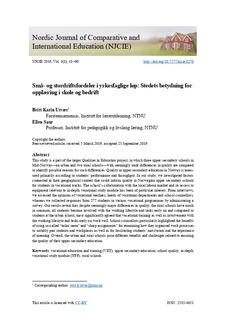| dc.contributor.author | Utvær, Britt Karin Støen | |
| dc.contributor.author | Saur, Ellen | |
| dc.date.accessioned | 2020-02-20T09:41:06Z | |
| dc.date.available | 2020-02-20T09:41:06Z | |
| dc.date.created | 2019-11-26T10:23:43Z | |
| dc.date.issued | 2019 | |
| dc.identifier.citation | Nordic Journal of Comparative and International Education (NJCIE). 2019, 3 (3), 43-60. | nb_NO |
| dc.identifier.issn | 2535-4051 | |
| dc.identifier.uri | http://hdl.handle.net/11250/2642797 | |
| dc.description.abstract | This study is a part of the larger Qualities in Education project, in which three upper secondary schools in Mid-Norway—an urban and two rural schools—with seemingly stark differences in quality are compared to identify possible reasons for such differences. Quality in upper secondary education in Norway is meas-ured primarily according to students’ performance and throughput. In our study, we investigated factors connected to their geographical context that could inform quality in Norwegian upper secondary schools for students in vocational tracks. The school’s collaboration with the local labour market and its access to equipment relevant to in-depth vocational study module has been of particular interest. From interviews, we accessed the opinions of vocational teachers, heads of vocational departments and school counsellors, whereas we collected responses from 277 students in various vocational programmes by administering a survey. Our results reveal that, despite seemingly major differences in quality, the rural schools have much in common; all students become involved with the working lifestyle and tasks early on and compared to students at the urban school, most significantly agreed that vocational training as well as involvement with the working lifestyle and tasks early on work well. School counsellors particularly highlighted the benefits of using so-called “tailor seam” and “sharp assignments” for examining how they organised work processes to suitably pair students and workplaces as well as for facilitating students’ motivation and the experience of meaning. Overall, the urban and rural schools pose different benefits and challenges related to ensuring the quality of their upper secondary education. | nb_NO |
| dc.language.iso | nob | nb_NO |
| dc.publisher | OsloMet University Library | nb_NO |
| dc.rights | Navngivelse 4.0 Internasjonal | * |
| dc.rights.uri | http://creativecommons.org/licenses/by/4.0/deed.no | * |
| dc.title | Små- og stordriftsfordeler i yrkesfaglige løp: Stedets betydning for opplæring i skole og bedrift | nb_NO |
| dc.type | Journal article | nb_NO |
| dc.type | Peer reviewed | nb_NO |
| dc.description.version | publishedVersion | nb_NO |
| dc.source.pagenumber | 43-60 | nb_NO |
| dc.source.volume | 3 | nb_NO |
| dc.source.journal | Nordic Journal of Comparative and International Education (NJCIE) | nb_NO |
| dc.source.issue | 3 | nb_NO |
| dc.identifier.doi | 10.7577/njcie.3270 | |
| dc.identifier.cristin | 1752266 | |
| dc.description.localcode | Copyright (c) 2019 Britt Karin Utvær, Ellen Saur. This work is licensed under a Creative Commons Attribution 4.0 International License. | nb_NO |
| cristin.unitcode | 194,67,80,0 | |
| cristin.unitcode | 194,67,70,0 | |
| cristin.unitname | Institutt for lærerutdanning | |
| cristin.unitname | Institutt for pedagogikk og livslang læring | |
| cristin.ispublished | true | |
| cristin.fulltext | original | |
| cristin.qualitycode | 1 | |

